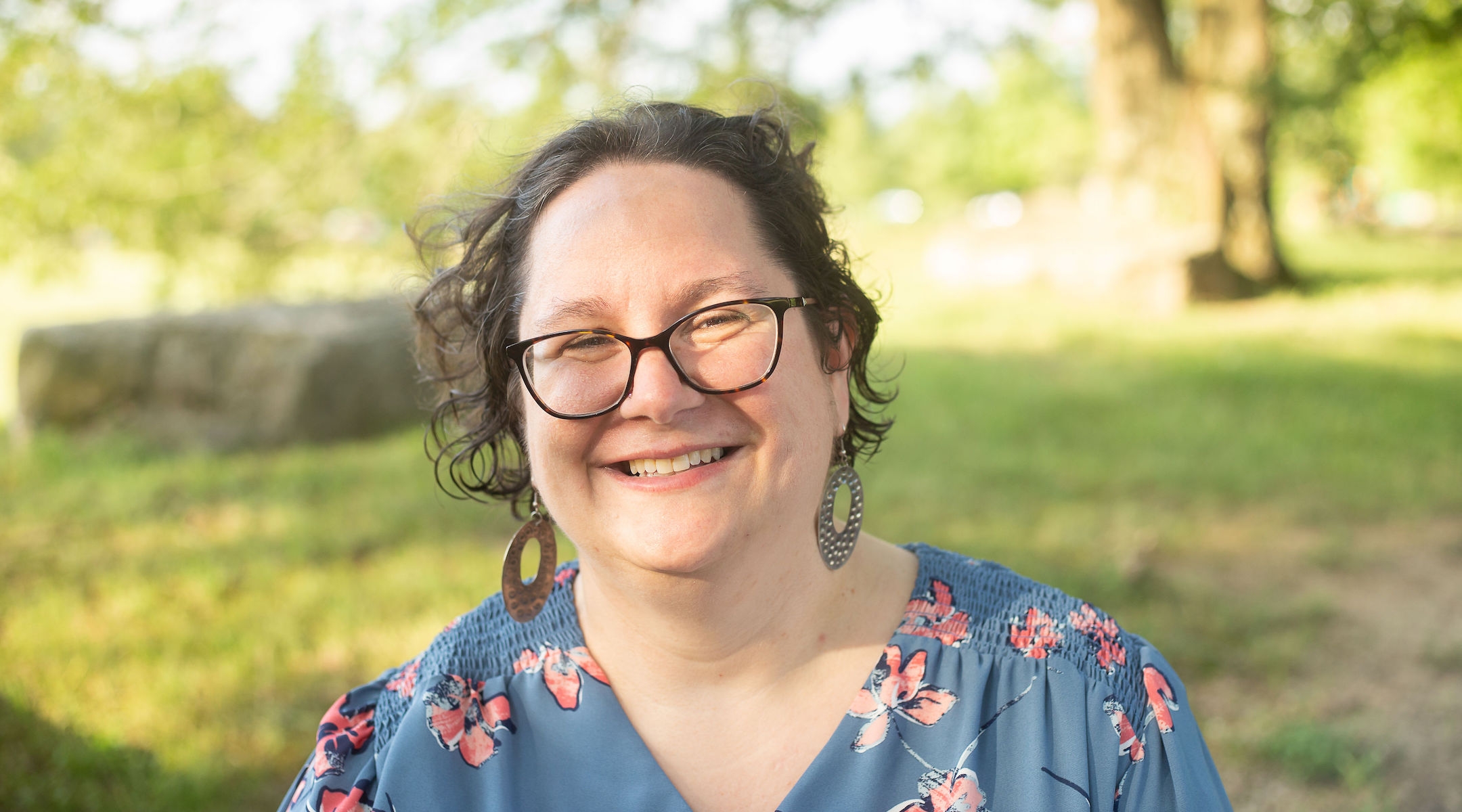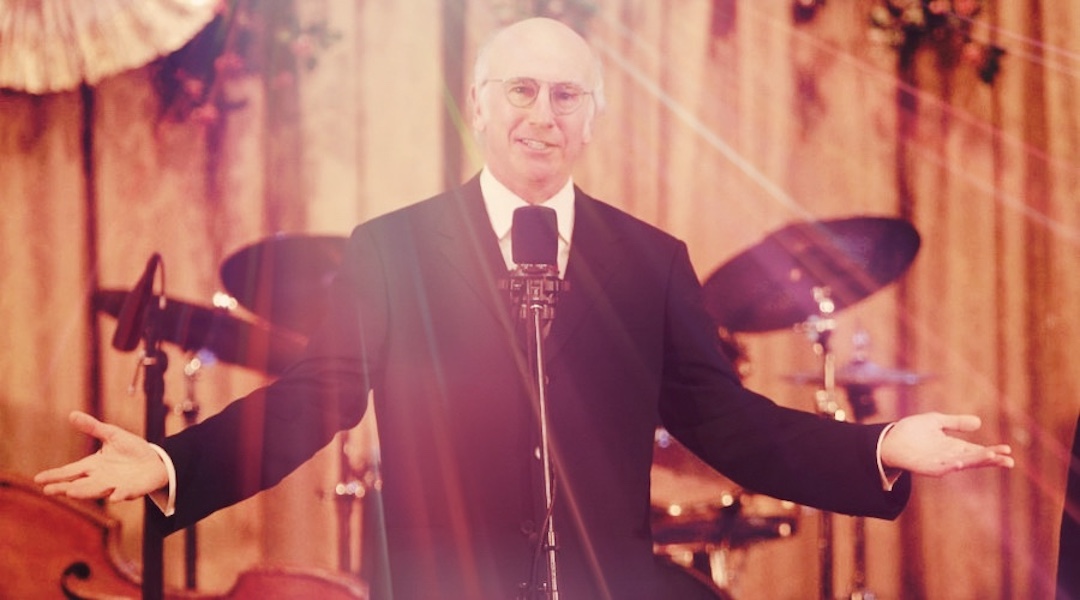(JTA) — In the 2020 comedy “Shiva Baby,” a 20-something young woman shows up at a house of Jewish mourners and gently offers her condolences. When she finds her mother in the kitchen, they chat about the funeral and the rugelach before the daughter asks, “Mom, who died?”
While “Shiva Baby” explores themes of sexuality and gender, the comedy almost never comes at the expense of Jewish tradition, which is treated seriously by its millennial writer and director Emma Seligman (born in 1995) even as the shiva-goers collide. It’s far cry from the acerbic way an author raised during the Depression like Philip Roth lampooned a Jewish wedding or a baby boomer like Jerry Seinfeld mocked a bris.
These generational differences are explored in Jenny Caplan’s new book, “Funny, You Don’t Look Funny: Judaism and Humor from the Silent Generation to Millennials.” A religion scholar, Caplan writes about the way North American Jewish comedy has evolved since World War II, with a focus on how humorists treat Judaism as a religion. Her subjects range from writers and filmmakers who came of age shortly after the war (who viewed Judaism as “a joke at best and an actual danger at worst”) to Generation X and millennials, whose Jewish comedy often recognizes “the power of community, the value of family tradition, and the way that religion can serve as a port in an emotional storm.”
“I see great value in zeroing in on the ways in which Jewish humorists have engaged Jewish practices and their own Jewishness,” Caplan writes. “It tells us something (or perhaps it tells us many somethings) about the relationship between Jews and humor that goes deeper than the mere coincidence that a certain humorist was born into a certain family.”
Caplan is the chair in Judaic Studies at the University of Cincinnati. She has a master’s of theological studies degree from Harvard Divinity School and earned a Ph.D. in religion from Syracuse University.
In a conversation last week, we spoke about the Jewishness of Jerry Seinfeld, efforts by young women comics to reclaim the “Jewish American Princess” label, and why she no longer shows Woody Allen movies in her classrooms.
Our conversation was edited for length and clarity
[Note: For the purpose of her book and our conversation, this is how Caplan isolates the generations: the Silent Generation (b. 1925-45), the baby boom (1946-65), Generation X (1966-79) and millennials (1980–95).]
Jewish Telegraphic Agency: Let me ask how you got into this topic.
Jenny Caplan: I grew up in a family where I was just sort of surrounded by this kind of material. My dad is a comedic actor and director who went to [Ringling Bros. and Barnum & Bailey’s] Clown College. My degrees were more broadly in American religion, not Jewish studies, but I was really interested in the combination of American religion and popular culture. When I got to Syracuse and it came time to start thinking about my larger project and what I wanted to do, I proposed a dissertation on Jewish humor.
The key to your book is how Jewish humor reflects the Jewish identity and compulsions of four sequential generations. Let’s start with the Silent Generation, which is sandwiched between the generation whose men were old enough to fight in World War II and the baby boomers who were born just after the war.
The hallmark of the Silent Generation is that they were old enough to be aware of the war, but they were mostly too young to serve. Every time I told people what I was writing about, they would say Woody Allen or Philip Roth, two people of roughly the same generation.

In “Funny, You Don’t Look Funny: Judaism and Humor from the Silent Generation to Millennials,” Jenny Caplan explores how comics treated religion from the end of World War II to the 21st century. (Courtesy)
The Roth story you focus on is “Eli, the Fanatic” from 1959, about an assimilated Jewish suburb that is embarrassed and sort of freaks out when an Orthodox yeshiva, led by a Holocaust survivor, sets up in town.
Roth spent the first 20 to 30 years of his career dodging the claim of being a self-loathing Jew and bad for the Jews. But the actual social critique of “Eli, the Fanatic” is so sharp. It is about how American Jewish comfort comes at the expense of displaced persons from World War II and at the expense of those for whom Judaism is a real thriving, living religious practice.
That’s an example you offer when you write that the Silent Generation “may have found organized religion to be a dangerous force, but they nevertheless wanted to protect and preserve the Jewish people.” I think that would surprise people in regards to Roth, and maybe to some degree Woody Allen.
Yeah, it surprised me. They really did, I think, share that postwar Jewish sense of insecurity about ongoing Jewish continuity, and that there’s still an existential threat to the ongoing existence of Jews.
I hear that and I think of Woody Allen’s characters, atheists who are often on the lookout for antisemitism. But you don’t focus on Allen as the intellectual nebbish of the movies. You look at his satire of Jewish texts, like his very funny “Hassidic Tales, With a Guide to Their Interpretation by the Noted Scholar” from 1970, which appeared in The New Yorker. It’s a parody of Martin Buber’s “Tales of the Hasidim” and sentimental depictions of the shtetl, perhaps like “Fiddler on the Roof.” A reader might think he’s just mocking the tradition, but you think there’s something else going on.
He’s not mocking the tradition as much as he’s mocking a sort of consumerist approach to the tradition. There was this sort of very superficial attachment to Buber’s “Tales of the Hasidim.” Allen’s satire is not a critique of the traditions of Judaism, it’s a critique of the way that people latch onto things like the Kabbalah and these new English translations of Hasidic stories without any real depth of thought or intellect. Intellectual hypocrisy seems to be a common theme in his movies and in his writing. It’s really a critique of organized religion, and it’s a critique of institutions, and it’s a critique of the power of institutions. But it’s not a critique of the concept of religion.
The idea of making fun of the wise men and their gullible followers reminds me of the folk tales of Chelm, which feature rabbis and other Jewish leaders who use Jewish logic to come to illogical conclusions.
Yes.
You write that the baby boomers are sort of a transition between the Silent Generation and a later generation: They were the teenagers of the counterculture, and warned about the dangers of empty religion, but also came to consider religion and tradition as valuable. But before you get there, you have a 1977 “Saturday Night Live” skit in which a bris is performed in the back seat of a luxury car, and the rabbi who performs it is portrayed as what you call an absolute sellout.
Exactly. You know: Institutional religion is empty and it’s hollow, it’s dangerous and it’s seductive.
Jerry Seinfeld, born in 1954, is seen as an icon of Jewish humor, but to me is an example of someone who never depicts religion as a positive thing. (Not that there’s anything wrong with that.)
“Seinfeld” is more a show about New York than it is necessarily a show about anything Jewish. The New York of Seinfeld is very similar to the New York of Woody Allen, peopled almost entirely by white, middle-class, attractive folks. It’s a sort of Upper West Side myopia.
But there’s the bris episode, aired in 1993, and written by Larry Charles. Unless you are really interested in the medium, you may not know much about Larry Charles, because he stays behind the camera. But he also goes on to do things like direct Bill Maher’s anti-religion documentary “Religulous,” and there’s a real strong case for him as having very negative feelings about organized religion which feels like a holdover from the Silent Generation. And so in that episode you have Kramer as the Larry Charles stand-in, just opining about the barbaric nature of the circumcision and trying to save this poor baby from being mutilated.
The few references to actual Judaism in “Seinfeld” are squirmy. I am thinking of the 1995 episode in which a buffoon of a rabbi blurts out Elaine’s secrets on a TV show. That was written by Larry David, another boomer, whose follow-up series, “Curb Your Enthusiasm,” is similarly known for its irreverence toward Judaism. But you say David can also surprise you with a kind of empathy for religion.
For the most part, he’s classic, old school, anti-organized religion. There’s the Palestinian Chicken episode where the Jews are rabidly protesting the existence of a Palestinian-run chicken restaurant near a Jewish deli, and where his friend Funkhouser won’t play golf on Shabbos until Larry gets permission by bribing the rabbi with the Palestinian chicken. There, rabbis are ridiculous and can be bought and religion is hollow and this is all terrible.
But then there’s this bat mitzvah montage where for one moment in the entire run of this show, Larry seems happy and in a healthy relationship and fulfilled and enjoying life.
That’s where he falls in love with Loretta Black during a bat mitzvah and imagines a happy future with her.
It’s so startling: It is the most human we ever see Larry over the run of the show, and I believe that was the season finale for the 2007 season. It was much more in line with what we’ve been seeing from a lot of younger comedians at that point, which was religion as an anchor in a good way — not to pull you down but to keep you grounded.
So for Generation X, as you write, Judaism serves “real, emotional, or psychological purpose for the practitioners.”
I wouldn’t actually call it respect but religion is an idea that’s not just something to be mocked and relegated to the dustbin. I’m not saying that Generation X is necessarily more religious, but they see real power and value in tradition and in certain kinds of family experiences. So, a huge amount of the humor can still come at the expense of your Jewish mother or your Jewish grandmother, but the family can also be the thing that is keeping you grounded, and frequently through some sort of religious ritual.
Who exemplifies that?
My favorite example is the 2009 Jonathan Tropper novel, “This Is Where I Leave You.” I’m so disappointed that the film adaptation of that sucked a lot of the Jewish identity out of the story, so let’s stick with the novel. In that book, where a family gathers for their father’s shiva, the characters are horrible people in a dysfunctional family writ large. They lie to each other. They backstab each other. But in scene where the protagonist Judd describes standing up on the bimah [in synagogue] to say Kaddish [the Mourner’s Prayer] after the death of his father, and the way he talks about this emotional catharsis that comes from saying the words and hearing the congregation say the words — it’s a startling moment of clarity in a book where these characters are otherwise just truly reprehensible.
Adam Sandler was born in 1966, the first year of Generation X, and his “Chanukah Song” seems like such a touchstone for his generation and the ones that follow. It’s not about religious Judaism, but in listing Jewish celebrities, it’s a statement of ethnic pride that Roth or Woody Allen couldn’t imagine.
It’s the reclamation of Jewish identity as something great and cool and fun and hip and wonderful and absolutely not to be ashamed of.

From left, Ilana Glazer, Abbi Jacobson and Seth Green in an episode of “Broad City” parodying Birthright Israel. (Screenshot from Comedy Central)
Which brings us to “Broad City,” which aired between 2014 and 2019. It’s about two 20-something Jewish women in New York who, in the case of Ilana Glazer’s character, anyway, are almost giddy about being Jewish and embrace it just as they embrace their sexuality: as just liberating. Ilana even upends the Jewish mother cliche by loving her mother to death.
That’s the episode with Ilana at her grandmother’s shiva, which also has the B plot where Ilana and her mother are shopping for underground illegal handbags. They spend most of the episode snarking at each other and fighting with each other and her mother’s a nag and Ilana is a bumbling idiot. But at the moment that the cops show up, and try to nab them for having all of these illegal knockoff handbags, the two of them are a team. They are an absolute unit of destructive force against these hapless police officers.
I think all of your examples of younger comics are women, who have always had fraught relationships with Jewish humor, both as practitioners and as the target of jokes. You write about “The JAP Battle” rap from “Crazy Ex-Girlfriend,” which both leans into the stereotype of the Jewish-American Princess — spoiled, acquisitive, “hard as nails” — and tries to reclaim it without the misogyny.
Rachel Bloom’s character Rebecca in “Girlfriend” self-identifies as a JAP, but she doesn’t actually fit the category. It’s her mother, Naomi, who truly is the Philip Roth, “Marjorie Morningstar,” Herman Wouk model of a JAP. So Bloom is kind of using the term, but you can’t repurpose the term when the original is still there.
So as an alternative, I offer up a new term: the Modern Ashkenazi American Woman. It’s very New York, it’s very East Coast, it’s very particular to a type of upbringing and community that in the 1950s and ’60s would have been almost exclusively Conservative Jews, and then may have become a bit more Reform as we’ve gotten into the ’90s and 2000s. They went to the JCC. They probably went to Jewish summer camp.
But even that doesn’t even really speak to the American sense of what Jewish is anymore, because American Jews have become increasingly racially and culturally diverse.
There is also something that’s happening historically with Generation X, and that’s the distance from the two major Jewish events of the 20th century, which is the Holocaust and the creation of Israel.
The Silent Generation and baby boomers still had a lingering sense of existential dread — the sense that we’re not so far removed from an attempted total annihilation of Jews. Gen X and millennials are so far removed from the Holocaust that they don’t feel that same fear.
But the real battleground we’re seeing in contemporary American Judaism is about the relationship to Israel. For baby boomers and even for some older members of Gen X, there’s still a sense that you can criticize Israel, but at the end of the day, it’s your duty to ultimately support Israel’s right to exist. And I think millennials and Zoomers [Gen Z] are much more comfortable with the idea of Israel being illegitimate.
Have you seen that in comedy?
I certainly think you can see the leading edge of that in some millennial stuff. The “Jews on a Plane” episode of “Broad City” is an absolute excoriation of Birthright Israel, and does not seem particularly interested in softening its punches about the whole idea of Jews going to Israel. I think we can see a trend in that direction, where younger American Jewish comedians do not see that as punching down.
You’re teaching a class on Jewish humor. What do your undergraduates find funny? Now that Woody Allen is better known for having married his adoptive daughter and for the molestation allegations brought by another adoptive daughter, do they look at his classic films and ask, “Why are you teaching us this guy?”
For the first time I’m not including Woody Allen. I had shown “Crimes and Misdemeanors” for years because I think it’s his most theological film. I think it’s a great film. And then a couple years ago, I backed off, because some students were responding that it was hard to look at him with all the baggage. He’s still coming up in conversation because you can’t really talk about the people who came after him without talking about him, but for the first time I’m not having them actually watch or read any of his stuff.
They have found things funny that I didn’t expect them to, and they have not found things funny that I would have thought they would. They laughed their way through “Yidl mitn fidl,” the 1936 Yiddish musical starring Molly Picon. I also thought they’d enjoy the Marx Brothers’ “Duck Soup” and they did not laugh once. Some of that is the fact that Groucho’s delivery is just so fast.
JTA has documented Jewish history in real-time for over a century. Keep our journalism strong by joining us in supporting independent, award-winning reporting.







